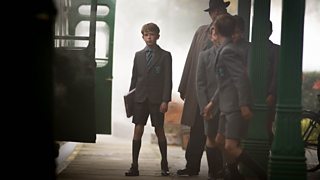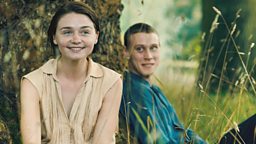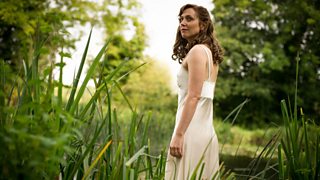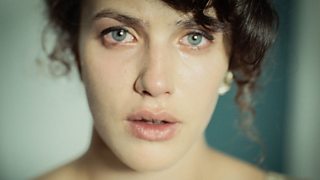Drowning, desire and coming of age - Iain Softley on directing The Outcast
Iain Softley is the Hollywood director responsible for giving Angelina Jolie her first leading role in the cult film Hackers and won critical acclaim for his big screen adaptation of the Henry James novel The Wings of the Dove. The Outcast is his first project for television.
Here, he explains about the differences between directing for the two mediums, why he wanted to direct the adaptation of Sadie Jones's novel and what was special about the cast of the drama.
If you can actually see the film playing in front of you in some form, it’s a really good sign that you’ll be able to achieve it successfully. I read The Outcast about a year after it came out and I was struck by a sense of how familiar the world seemed to be - even though it took place before I, and the writer Sadie [Jones], was born.

It starts in the 1940s, in the rural Surrey commuter belt. At the centre is a ten year old boy, Lewis, and his mother who are waiting the return of his father from the war. For a short time we get the sense of a family trying to rediscover the happy period they had before. But then tragedy strikes – the young Lewis is on a picnic with his mother Elizabeth and swimming in the river when she gets trapped underwater and drowns. His father doesn’t understand how Lewis couldn’t have done more to save her. Not only does he [Lewis] have difficulties dealing with it, but his father and the whole village do as well.
Not only was it a very intimate story about a family and about loss and ultimately about love, but it had a broader canvas. It was a story about the social fabric of England and the way it was moving from this post war period and [how] it was being forced to change.
One of the things Lewis is at home with is being almost a ‘man boy’. It was very important in casting Lewis that the actor could have the combination of the vulnerability of youth, but at the same time, a kind of physicality and sexuality.
We have two different actors who play Lewis. Finn Elliot [young Lewis] is a wonderful young actor with incredible power and stillness – it’s the first thing he’s done and I think he’s extraordinary in it – and then a much better known actor, George MacKay, who plays the teenage Lewis over two or three years. George has this wonderful range; he’s able to be very charismatic, but at the same time to be very vulnerable.

The differences [between directing for television and cinema] are quite mundane! There’s two big differences, in my experience; budget and time! You have to work at a very fast pace and so you’re thinking on your feet a lot of the time, no matter how much preparation you do (and I like to be prepared). You have fewer takes [but] there’s an advantage to it as [the actors] have to stay in character for most of the day, rather than going off and waiting for an hour while the lighting is changed. It means that you’re in that world for longer, which I think is a positive thing.

There are a lot of moments of non-dialogue sequences where we have to get inside Lewis’ head and so the visual storytelling is very important, as is the sound design and music; we recorded with quite a large orchestra at Abbey road because I wanted the score to have the same impact on the story as it would in a feature film. It adds another layer of narrative, a counterpoint to the onscreen narrative we’re seeing.
Edward Shearmur, the score composer, came up with this very eerie sound that’s really slowed down church bells. The church plays a big role in the village and the story, so these bells are part of the soundscape. And Jeremy Price the sound designer came up with this ticking clock that he also slowed down - a pulse that would increase with Lewis’ anxiety.
The drowning scene [in part one] was very challenging. I always felt I knew how to do it but that it would involve everyone being at the top of their game – including me! We had 11 year old Finn in a freezing cold river and Hattie Morahan [who plays Elizabeth] had to go through Aqua-Lung training. We had divers in the river and they were always just a foot away, just out of shot. We did do some of it in a tank, but a lot of it was done in the river.
The river is a big element of the story. It’s a pastoral, idyllic scenario that’s suddenly interrupted and you’ll see when you watch it that it takes us through an emotional and dramatic journey.
In this story the moments of sexual encounters are very important story-wise. I discussed these in great detail with the actors. I had a choreography for them - maybe unlike other scenes where I’d give the actors the set - and I’d be quite detailed with it; “you should do this” and “put your hand here”, because in order for there not to be any misinterpretations of what’s going on, you need to be quite scientific. It’s not sexy – it’s really about being methodical. And a lot of it is about mutual trust. The actors have to trust me and realise that there’s nothing gratuitous and it’s for the story. If everybody realises it’s right in storytelling terms, then it’s just a question of us agreeing.

The Outcast was a wonderful opportunity on a lot of levels for me, but one of the most important things was to be able to work with such a great cast, some of which I knew personally – but had never worked with before – and some who I was meeting for the first time. I’d seen Hattie Morahan on the stage in A Doll’s House and was completely blown away by her performance – from then I knew I wanted to work with her. Her wonderful theatre training means that the detail she brings is incredible. She’s not on the screen [as Elizabeth] for very long and haunts the rest of the story, so she has to have presence – I think Hattie did that brilliantly.

Alice is a character in a very difficult situation and has a very complex journey. Jessica Brown Findlay was younger than I thought Alice was going to be, but I think that helped to reinforce the vulnerability that she felt; how like a fish out of water she was. She was extraordinary and had some very difficult scenes.
I’ve known Greg Wise for a while and as soon as I saw him, I knew he’d make the perfect Gilbert. Nat Parker has a very bold role to play – someone who has such difficult personality traits as Dickie – not a lot of actors embrace so generously someone they don’t like.
Daisy Bevan as Tamsin was wonderful. I hadn’t seen Tamsin like that, but she had a combination of a innocence and vulnerability, but also able to be sort of minxy – the pony club heroine – whilst maintaining complexity.
And then of course, Jessica Barden as Kit. Age-wise, probably the most challenging of roles because she starts as a girl aged 12, and then reaches womanhood in the story, whereas the other characters stay within the same age range. One of the things that was extraordinary was that one day we would shoot her as a 12 year old and then the next we’d film her as a 15 year old and she’d physically change.
-
![]()
Find out who's who in The Outcast

